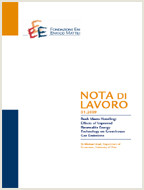Nonlinearity, Heterogeneity and Unobserved Effects in the CO2-income Relation for Advanced Countries

20.10.2013
Massimiliano Mazzanti, Antonio Musolesi
C14, C23, Q53
Environmental Kuznets Curve, Semiparametric Models, Generalized Additive Mixed Models, Interaction Models
Climate Change and Sustainable Development
Carlo Carraro
We study long run carbon emissions-income relationships for advanced countries grouped in policy relevant groups: North America and Oceania, South Europe, North Europe. By relying on recent advances on Generalized Additive Mixed Models (GAMMs) and adopting interaction models, we handle simultaneously three main econometric issues, named here as functional form bias, heterogeneity bias and omitted time related factors bias, which have been proved to be relevant but have been addressed separately in previous papers. The model incorporates nonlinear effects, eventually heterogeneous across countries, for both income and time. We also handle serial correlation by using autoregressive moving average (ARMA) processes. We find that country-specific time-related factors weight more than income in driving the northern EU Environmental Kuznets. Overall, the countries differ more on their carbon-time relation than on the carbon-income relation which is in almost all cases monotonic positive. Once serial correlation and (heterogeneous) time effects have been accounted for, only three Scandinavian countries – Denmark, Finland and Sweden – present some threshold effect on the CO2-development relation.
***
Suggested citation: Mazzanti, M., A. Musolesi, (2013), ‘Nonlinearity, Heterogeneity and Unobserved Effects in the CO2-income Relation for Advanced Countries’, Nota di Lavoro 91.2013, Milan, Italy: Fondazione Eni Enrico Mattei.
